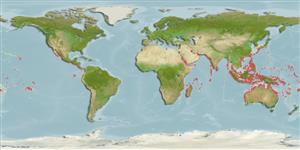Common names from other countries
Classification / Names / Names
ชื่อสามัญ | ชื่อพ้อง | Catalog of Fishes (gen., sp.) | ITIS | CoL | WoRMS
Environment: milieu / climate zone / depth range / distribution range
นิเวศวิทยา
; กร่อย; ระดับความลึก 0 - 10 m (Ref. 96667). Tropical
Indo-Pacific.
Length at first maturity / ขนาด / น้ำหนัก / Age
Maturity: Lm ? range ? - ? cm Max length : 8.0 cm CW เพศผู้/กระเทย; (Ref. )
Surface of carapace smooth, ridges low but distinct; front with 6 equal-sized, rounded lobes. Color: dark to olive green overall.
Also caught by nets (Ref. 343). This species possess toxins but in low toxicities, and are therefore considered as a toxin-free crab (Ref. 130560). Found along the neritic zone (Ref. 97241). Inhabits shallow non-reef habitat with soft substrates (Ref. 106854), and intertidal mudflats (Ref. 128960). Estuarine (Ref. 106854). Prefers areas near mangroves, on mangrove swamps per se (Ref. 8752) or with muddy-rocky substrates (Ref. 343) in intertidal platforms (Ref. 8752). Also found in reef areas. A free-living predatory carnivore (Refs. 97241, 128960). Feeds mainly on slow-moving invertebrates colonizing mangrove swamps; also a scavenger (Ref. 8752).
Life cycle and mating behavior
วัยเจริญพันธุ์ | การสืบพันธุ์ | การวางไข่ | เซลสืบพันธ์ของเพศเมีย(ไข่) | ความดกของไข่ | ตัวอ่อน
Members of the order Decapoda are mostly gonochoric. Mating behavior: Precopulatory courtship ritual is common (through olfactory and tactile cues); usually indirect sperm transfer.
Ng, P.K.L. 1998. (Ref. 343)
IUCN Red List Status (Ref. 130435)
CITES status (Ref. 108899)
Not Evaluated
Not Evaluated
Threat to humans
Human uses
การประมง: การค้า
| FishSource | ทะเลรอบๆเรา
เครื่องมือ
แหล่งที่มาจากอินเตอร์เน็ต
Estimates based on models
Preferred temperature
(Ref.
115969): 24.3 - 29.3, mean 28.3 (based on 3830 cells).
ความสามารถในการกลับคืนสู่ปกติ
ความสูง, เวลาต่ำสุดที่จะทำให้ประชากรเพิ่มขึ้นเป็น 2 เท่าใช้เวลาน้อยกว่า 15 เดือน (K=1.7).
Vulnerability
Low vulnerability (10 of 100).
Price category
Unknown.
